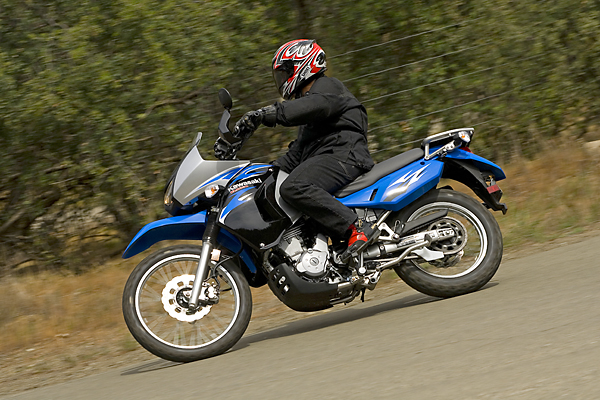
Nearly 400 miles in two days. It’s a good way to get to know a new motorcycle, and represents one of the most intense press introductions I have ever attended. The bike is the 2008 Kawasaki KLR650, and the venue was the stunningly beautiful California coast between Monterey and Cambria. 270 miles on the first day, including 20 or so off road — all through the foothills and canyons just inland from the most beautiful coastline in the world (no arguments, please). Day two included a 110 mile blast up legendary Highway 1 back to Monterey from Cambria.
The riding was epic (sorry about the cliche — now even worse due to the TV show of the same name), the hosts gracious, and the accommodations luxurious. All enough to bias the most prudish journalist, but we remain strong and steadfast in our search for the truth about this redesign of a Kawasaki classic.
A classic, indeed. When the first KLR650 was introduced to the US market, it was 1987. The first major redesign is the bike you are looking at here — 20 years in the making. Minor changes were made during those 20 years (with 1996 involving the largest number of minor changes), but the bike retained the character it started with. A unique character, and one that I find difficult to describe.
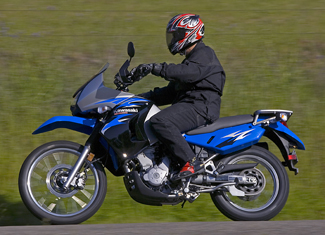
This is a dual sport bike, and a very successful one. According to Kawasaki, the KLR650 has consistently out-sold all competitors — double the sales of the next best selling dual sport (Suzuki’s DR-Z400S). Achieved with a 20 year old design. If you are scratching your head, you are doing exactly what I was doing (figuratively, at least) when I heard this information last week. What is it about this bike, anyway?
For one thing, the KLR650 is inexpensive. For many years it retailed for less than $5,000.00, (the 2007 model had a US MSRP of $5,199). While a few hundred bucks cheaper than some of the competition (the DR-Z400S retails for $5,599.00, and the Honda XR650L retails for $5,849.00, for example), price alone cannot explain the KLR650’s sales success.
Reading what dozens of KLR650 owners have posted on the Internet about the bike, I start to understand its fundamental appeal. Simple, reliable, comfortable on the highway, yet more capable off-road than many other large-displacement dual sports. Okay, so it is the practical side of motorcycling that drives customers to the KLR650. The low price fits into this logic. But where is the passion? Isn’t motorcycling about passion as well? I read further, and found something that looks like passion, but boils down to trustworthiness and practicality.
There is a reason why the U.S. military buys so many KLR650s (albeit, many fitted with an aftermarket diesel engine). The bike rarely breaks, and when it does it is easier to fix than many bikes with more modern (i.e., more complicated) designs. This leads us to a paradox about the 2008 model. There are grumblings among the KLR faithful that Kawasaki may just have done something unnecessary by “modernizing” this trusted, reliable old friend. In other words, one reason the KLR650 sold so well after 20 years is the fact that . . . it’s a proven, 20-year-old design! For many of these owners, new is bad.
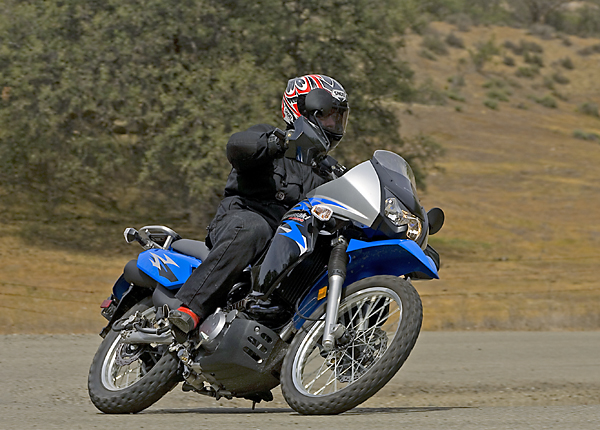
I am here to report, after nearly 400 miles, that in this instance, new is good. Very good. The things you never liked about your old friend are gone, and replaced with better things that will make for an even better friend. I’m not kidding.
Even old friends can annoy you. According to Kawasaki’s research, the old KLR650 had a seat that was too soft (and became uncomfortable on even moderately long rides), had weak brakes (particularly, the front brake), overly soft suspension for most purposes, wind protection that caused excessive buffeting, and less than ideal power from its 20-year-old engine design. A trusted friend, but a friend in need of some self-help. At the same time, a friend that had to retain its basic goodness and loyalty.
So what changes did Kawasaki make? There is nothing new on this motorcycle that makes it less reliable. It still has the same engine (with several, important changes discussed below) fed by a CV carburetor (not fuel injection), still has a 5-speed transmission, and you warm up the bike in the morning with a manual choke mounted on the handlebar.
Engine power is dramatically improved (we did test the older model here), with revised cam timing, revised ignition mapping (aided by new digital ignition), modified cylinder head with new intake porting, improved piston rings (to reduce oil consumption), and a new, seamless exhaust pipe that allows for smoother, more efficient exhaust flow.
A new, lighter radiator has greater surface area and significantly increased cooling efficiency (the bike ran very cool despite some pretty abusive riding during our test).

The new KLR650 is also stiffer and more robust feeling due to the increased size of wheel spoke gauge (now 4mm, versus 3.5mm on the old bike) and much more rigid forks, which now measure 41mm in diameter versus 38mm on the older design.
Suspension travel was reduced slightly front and rear. The fork now travels 7.9 inches (versus 9.1), and the shock 7.3 inches (versus 8.1). Less static sag in the fork and the shock means useful travel is not too far from the older design, and the new suspension generally has a slightly stiffer, more controlled feel (no wallowing). A new swingarm design not only looks better, it is stiffer and works well with a redesigned rear shock linkage. The shock is adjustable for rebound damping and spring preload.
New brakes are much stronger. The front brake disc diameter has been increased from 260mm to 280mm, and is now squeezed by a new two-piston caliper. The rear disc also has a two-piston caliper.
Everyone will notice the new bodywork and larger fairing. Kawasaki claims it spent a great deal of time dialing in the aerodynamics of this motorcycle for improved rider comfort and less wind buffeting.
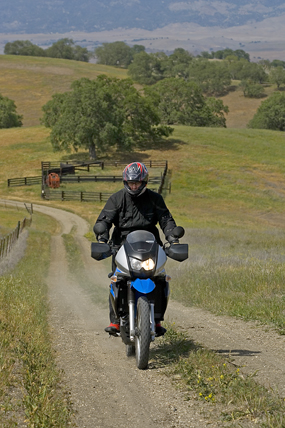
The alternator is now rated at 17 amps (versus 14.5 on the old bike). Part of this increase is designed to deal with the new, two-bulb headlight, which is extremely bright. Kawasaki claims that the system has enough power to deal with heated grips and other accessories, as well.
The seat is the same shape, but features denser, stiffer foam intended to offer greater comfort on longer rides.
A new instrument panel has a speedometer, tachometer, odometer, trip meter and water temperature gauge. Significantly, it is now attached directly to the motorcycle frame, and does not add heft to the steering feel.
The rear luggage rack is larger, and the passenger grab handles are moved back, out of the way to permit easier mounting of saddle bags.
All of these changes, as we found out, add up to a much more enjoyable, functional KLR650.
The engine performance is vastly improved. The bike still does not accelerate like a hot rod, but there is significantly more power available down low and up top. The spread of useful power is now huge. The bike even likes to rev now, and does not run out of steam above 5,000 rpm. In fact, the bike never really felt like it wanted to stop revving before redline. If you have ridden the old model, this comes as quite a shock. The bike felt smoother and stronger down low, as well, with no juddering.
That same 5-speed transmission now allows for comfortable freeway cruising at 80, even 85 mph. The bike will pull well beyond this speed (we saw an indicated 100 mph without much trouble). The old machine, by contrast, didn’t seem to like cruising above 75 mph for extended periods of time.

Almost as shocking as the engine performance is the new aerodynamics. The wind protection is simply outstanding. With plenty of coverage below helmet level, I never experienced any significant wind buffeting, which is all the more remarkable given the swirling, coastal winds we occasionally dealt with on the ride. Apparently, taller windscreens will be made available (both by Kawasaki and the aftermarket), but I found the stocker so good I wouldn’t want to change it. The aerodynamics also seem to make the bike feel more planted and sure of itself at higher freeway speeds (complimenting the engine power). Kawasaki claims that even the shape of the new front fender contribute to this sensation. Whatever the reasons, it was a pleasant and dramatic improvement over the old model.
At a claimed dry weight of 386 pounds, the KLR650 is on the porky side for a single-cylinder dual sport, but it carries the weight well — for the most part. The bike does feel top heavy, and handles slower, when you go from a nearly empty tank to a full 6.1 gallons. Nevertheless, the wide handlebars provide good leverage, and we were able to hustle the bike through the twisties effectively. Off-road, that weight deserves your respect and attention. You cannot ride this bike like a motocrosser, of course, and the stock dual sport tires, which provide surprisingly good grip on the road, can have the bike moving around quite a bit underneath you off road when you push it.
The bike has a solid, planted feeling both on-road and off-road. Once you master the technique off road (subtle inputs and no quick, sudden moves), you can make quick progress on fire roads and even tackle tighter, gnarlier stuff. The smooth low end power is a big help here, as is the stiffer fork and wheels.
Overall, the new KLR650 has a very good handling balance. It is a big, heavy bike, but ridden correctly does exactly what you tell it to do. In addition to high speed freeway, twisty tarmac, and several different types of dirt sections, we rode some really slippery, sand dusted back roads on the new KLR650. Twice, I slid both the back and front tires from the inside of a corner all the way to an outside berm, but never really felt like I was out of control. I don’t think I could have done this on the older bike (at least, without a fork brace).
The 5-speed transmission worked throughout the test without complaint, and the gearing seemed just about perfect for the newfound, wider powerband. The smoother engine made 5th work well even at higher freeway speeds (dedicated highway travelers could add a tooth to the countershaft sprocket).
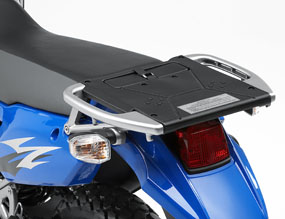
The seat was much more comfortable than the older model, but still a compromise for extended highway travel. While the older saddle might have you uncomfortable after just 20 or 30 minutes on the road, the denser foam didn’t bother me until a couple of hours had past in the saddle. If I were to use this bike primarily on-road, I would consider an aftermarket seat. The new seat really isn’t too bad, however.
The new instrumentation was legible, and the new headlights (even though we rode primarily during the day — primarily, because we rode in some dark, overcast, rainy conditions, as well) seemed dramatically brighter than the old headlight. Dual bulbs, higher wattage, and a more modern reflector design get the credit.
Despite aggressive street riding, the new brake system never lacked adequate power or faded. Again, if you have ridden the older model, you will be shocked by the power and control available from the new front brake. The new dual piston caliper out back takes some getting used to — it is much more powerful than the older rear brake and can lead to lock-ups before you calibrate your right foot to deal with it.
As with any big single, highway cruising revealed some vibration, but it was very well controlled and never led to significant discomfort. In fact, the new engine feels so much smoother than the old one that it is now a pleasure to ride at elevated highway speeds.
The new suspension settings are hard to fault. The big KLR never felt like it was wallowing, and tracked much more accurately than the old bike. The big 21 inch front wheel hit some gnarly stuff during our test (both on-road and off-road), but always felt plush and controlled. We also never bottomed the fork or the shock.
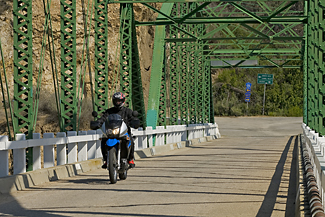
The stiffer suspension (particularly, the beefier front fork), stiffer wheels, improved aerodynamics and broader engine power add up to a KLR that is dramatically improved, without changing its character. It remains a reliable, willing partner both on-road and off-road. It is still one of the few bikes that provides miles and miles of highway comfort yet can tackle just about any off-road situation the adventure tourer might consider worthwhile.
This is not the bike for you if off-road blasting is your primary focus. There are plenty of lighter, more nimble dual sports available. At the same time, the KLR offers substantial off-road capabilities while being one of the most comfortable (if not the most comfortable) dual sports ever made for highway travel. Frankly, the new KLR650 is so comfortable on the highway , and provides such good wind protection, that it could seriously be considered as an alternative to a dedicated sport tourer.
The 2008 Kawasaki KLR650 is available at dealers now at a US MSRP of $5,349. Colors available include Candy Lime Green, Sunbeam Red, and Blue 21 (don’t ask me where the “21” comes from). Take a look at Kawasaki’s web site for additional details and specifications.






